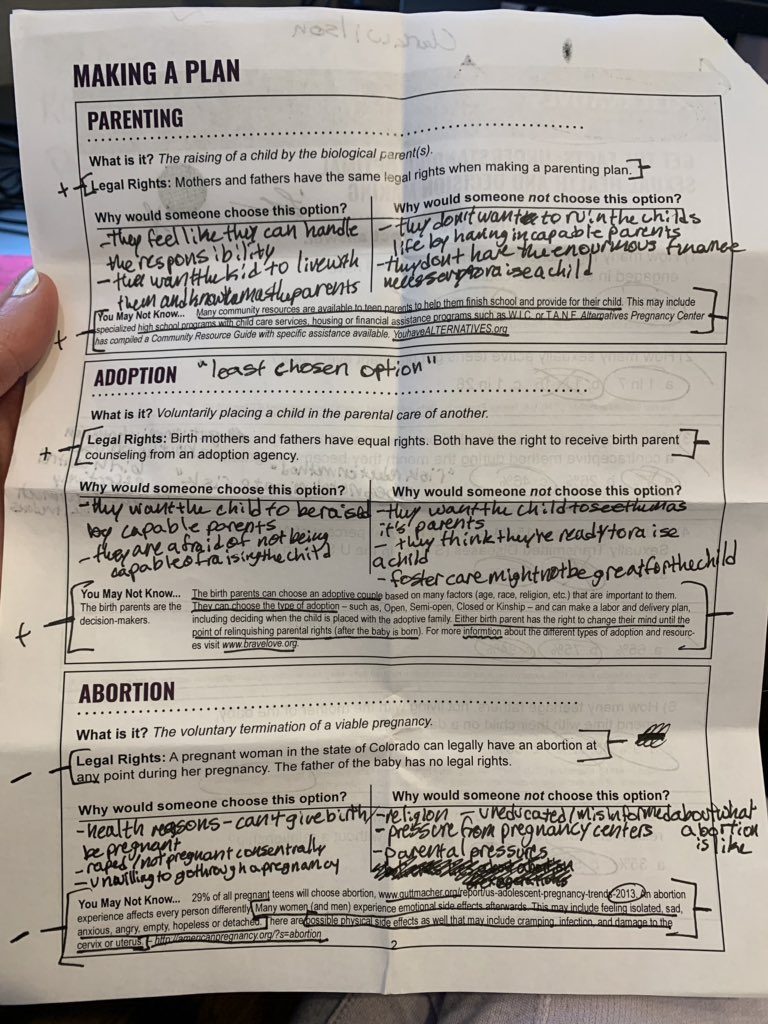When representatives from Alternatives Pregnancy Center began giving a presentation to his freshman health class at a public school in Highlands Ranch earlier this month, Clark Wilson already knew what the organization was — an anti-abortion crisis pregnancy center, or CPC, that uses deceptive tactics to sway women’s reproductive health care decisions.
As he sat and listened to the 90-minute lesson, Clark took notes, paying particular attention to anything he thought stood out as biased or potentially false, he told the Colorado Times Recorder.
Classroom handouts distributed by Alternatives Pregnancy Center and provided to CTR by Clark contain much of the usual misleading information used by CPCs to paint abortion as risky and undesirable.

Handout provided by the Wilsons shows how Alternatives Pregnancy Center casts abortion in a negative light.
Clark’s mother Darien Wilson told CTR that she was “completely shocked” when she learned that a CPC was allowed to give a presentation at her son’s school, and was particularly frustrated with how they framed abortion as a risky procedure when, in reality, it’s safer in the U.S. to have an abortion than to give birth.
“They say all the negative things about abortion and only the positive things about parenting, so that’s something that really concerns me,” she said. “Every woman I know after they give birth, even if they have a wanted, desired pregnancy, your body is never the same. And literally, women die [giving birth], particularly women of color in this country, so downplaying that is very concerning to me.”
The U.S. has the highest maternal mortality rate of any developed country in the world, and that rate continues to rise while other countries are making childbirth safer. On top of that, Black women in the U.S. are three times as likely to die during childbirth than White women.
The handout states in its section on abortion that “many women (and men) experience emotional side effects afterwards. This may include feeling isolated, sad, anxious, angry, empty, hopeless or detached. There are physical side effects as well that may include cramping, infection, and damage to the cervix or uterus.”
The handout doesn’t note that these side effects are also possible when one gives birth, and instead states that “many community resources are available to teen parents.”
It’s typical for CPCs to warn that abortion commonly causes psychological problems, despite a lack of scientific evidence to support such a claim. In fact, a comprehensive study from the American Psychological Association found no significant correlation between abortion and mental health. The study did, however, reveal that perceptions of stigma, need for secrecy, and low social support for the abortion decision can be a predictor for those who do end up having negative psychological side effects. Similarly, a different study found that women are more likely to experience mental health issues if they’re denied access to an abortion than if they’ve received one.
When asked for a response to Darien Wilson’s concerns about the message the lesson sends about abortion, Linda Saccomano, Interim Executive Director for Alternatives Pregnancy Center, said, “I would invite her to meet with us, because what we’re looking for is solutions to this conversation. We are not a political organization; we are an organization whose intent is to help people in a compassionate and empathetic way, so if there’s some solution-based thinking that we could do with a parent, we would love to hear what they have to say.”
Pressed on whether it’s fair to portray abortion as risky when childbirth is in fact riskier, Saccomano said, “I’m not sure that that’s a correct statement to say it’s safer to have an abortion than it is to give birth. There are certainly pockets of populations that do have a high maternal mortality rate, but I’m not sure about that overall statement being a fact.”
“It is not our intention to mislead anyone but to create conversation and awareness,” she added.
Darien Wilson also took issue with the fact that they promoted an “abortion pill reversal” process for women who change their minds about wanting to terminate their pregnancies after taking the first dose of the abortion pill, a process which hasn’t been approved by the Food and Drug Administration and isn’t recommended by American College of Obstetricians and Gynecologists. ACOG has warned that in addition to being just as effective as doing nothing at all to reverse an abortion, this method, which involves a series of oral or injected doses of the hormone progesterone over the course of several days, poses a variety of health risks.
“The abortion pill reversal thing is really not ok,” Darien said.
Asked to address concerns about abortion reversal, Saccomano said, “Progesterone is an FDA approved product.”
While the hormone progesterone is FDA approved for some uses, it has not been approved for the purpose of reversing an abortion.
In addition to being scientifically dubious, pro-choice advocates see the abortion reversal method as a tool used by the anti-choice movement to weave the false narrative that women seeking abortions make hasty or uninformed decisions that they later come to regret.
Clark said that the presentation seemed to be downplaying the effectiveness of contraceptives using misleading statistics.
On a multiple choice quiz, Alternatives asks students, “How many women in unintended pregnancies were using a contraceptive method during the month they became pregnant?” [CTR emphasis]
“The answer that they gave us to the question was, 46 percent of women in unintended pregnancies were using contraceptives during the month they became pregnant, and that’s misleading because it implies that 46 percent of people who use contraceptives become pregnant, when that’s not the case at all,” Clark said.
Even when accounting for human error, the most commonly used contraceptive methods are very effective at preventing pregnancy. For example, with typical use, birth control pills are 93 percent effective, while condoms are 87 percent effective.
When asked to provide a source for the statistic, Saccomano pointed to a study from the Guttmacher Institute, the objective for which was to determine what contraceptives are most commonly used among abortion patients, not the efficacy of contraceptives in general. In this particular study, condoms were the most widely used contraceptive method.
“It doesn’t matter if you used a contraceptive on Monday if you had unprotected sex on Friday,” Darien Wilson said.
In recent years, CPCs have been cropping up in huge numbers across the U.S., and now vastly outnumber abortion clinics. Some of them receive federal funding. And some, like Alternatives Pregnancy Center, have been teaching in sex ed in public schools for years.
Darien Wilson said that when she shared her concerns with her son’s school, she was told that Alternatives had been giving their presentation there for the past decade.
“How many kids have had this misinformation taught to them and didn’t know that these are fake clinics?” she asked.
Colorado’s New Sex Ed Law Will Keep CPCs Out of Most Public Schools
As it turns out, Clark knows a lot more about sex ed than most kids. He had recently been spending his free time testifying at Colorado’s capitol in support of a bill to strengthen public school sex ed programs. His interest in the issue was sparked by what he was taught in sex ed the previous year, when he was in eighth grade, which included abstinence-only methods that shame sexually active teens.
“I was pretty mad because this is the second inaccurate sex ed that I’ve had, and also because I just spent a whole bunch of time in the past couple of months trying to pass the sex ed bill that will stop things like this from happening,” he said. “Then here I am in class having the same thing I just tried to help prevent happen to me.”
Clark’s time spent at the Capitol appears to have paid off, now that the bill has been approved by lawmakers. Democratic Governor Jared Polis is expected to sign it into law any day now.
The bill lays out updated content requirements for public school sex ed programs. That includes a ban on abstinence-only teaching, more LGBTQ inclusivity, and mandated lessons on consent. It also aims to ensure students aren’t getting false or biased information about abortion.
Charter schools, however, can request a waiver from the state board of education if they don’t want to adhere to the new curriculum requirements, a late change that was made to the bill before it was finally approved by lawmakers with just a day remaining in the legislative session. Charter school enrollment in Colorado makes up 13% of total public school enrollment in the state.
Under current law, schools can decide which pregnancy outcomes they wish to teach, if any. Elizabeth Hinkley, Reproductive Rights Policy Counsel for the ACLU of Colorado, told CTR that that often means abortion is either stigmatized or left out of the conversation entirely, an issue the bill tackles head-on.
“What the bill does, is that if a school wants to teach pregnancy outcome options, then they must teach all of them, and they must present them in a way that is objective and unbiased and does not favor or endorse one option over another,” she said.
That means organizations like Alternatives Pregnancy Center will no longer be able to come into most public school classrooms to teach sex ed.
In addition, the bill automatically bans schools from engaging organizations that receive government funding under Title V, a federal grant program for teaching abstinence-only education. Hinkley said that because Alternatives Pregnancy Center is a current Title V grantee, it would be clearly barred.
“The policy and the law is clear,” said Hinkley. “If you’re providing the type of instruction that CPCs provide, then you’re not complying with state law.”
But that doesn’t mean parents should stop paying attention to what their kids are learning in sex ed. According to Hinkley, the Colorado Department of Education doesn’t have enforcement powers or the authority to fine or sue school districts if they don’t comply with sex ed mandates.
“The enforcement piece is where things get tricky,” said Hinkley.
In addition to using grant money as an incentive for school districts to teach comprehensive sex ed, Hinkley said they’re relying on students and parents to make sure schools are complying with the new requirements.
“What we’re focusing on in terms of enforcement is working with activists, students and parents and educating them on what state law requires as far as content requirements, and providing them with tools and resources they need to advocate, whether it’s to the specific educator, or the principle, or the school board,” she said.
That means families like the Wilsons may have more work to do to ensure they’re getting the comprehensive sex ed that the law requires.



